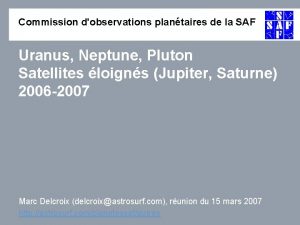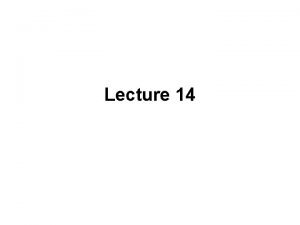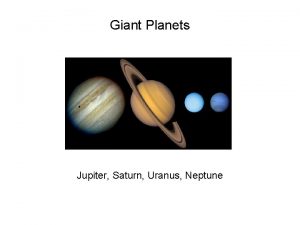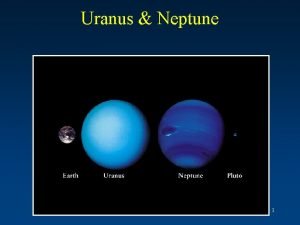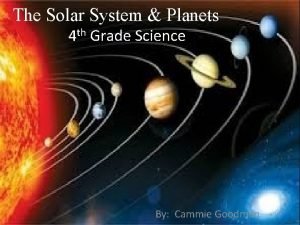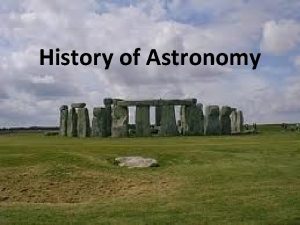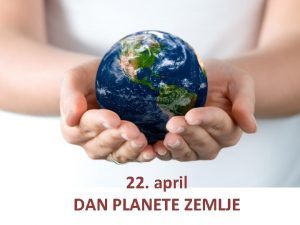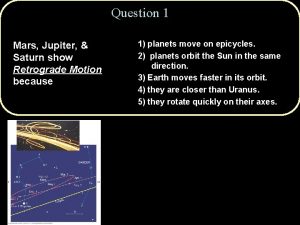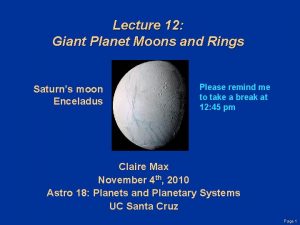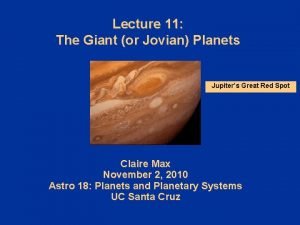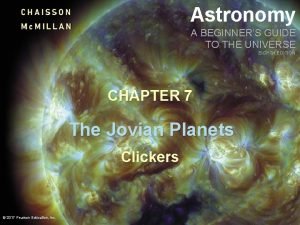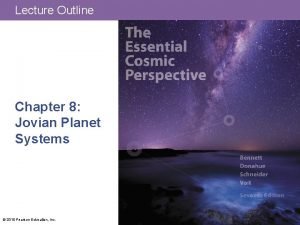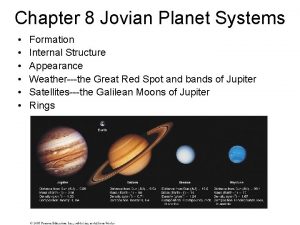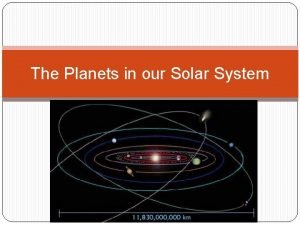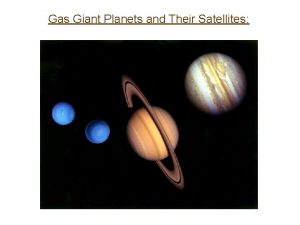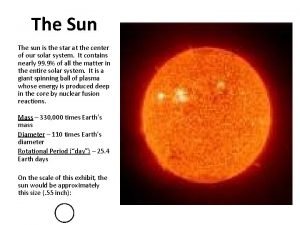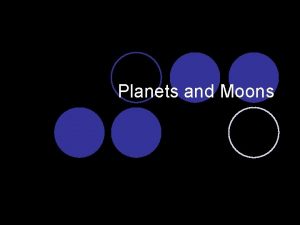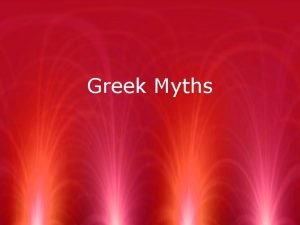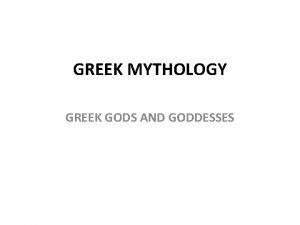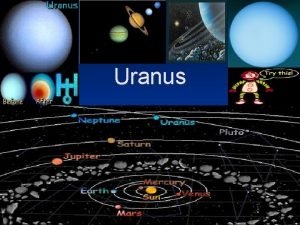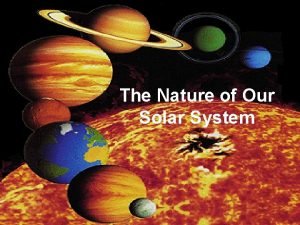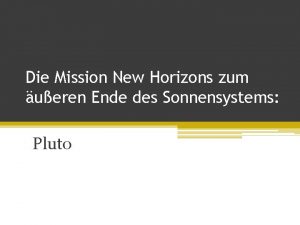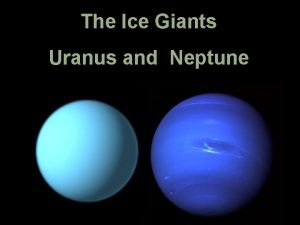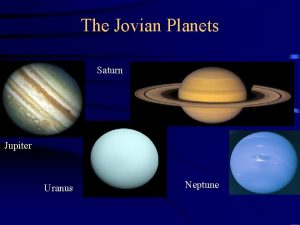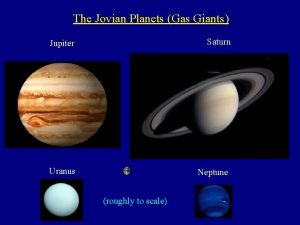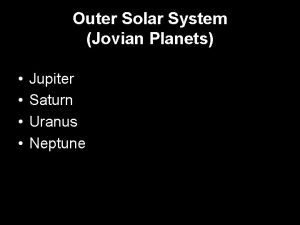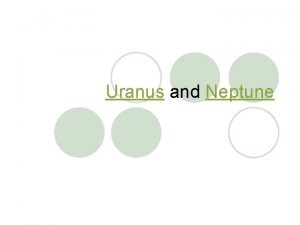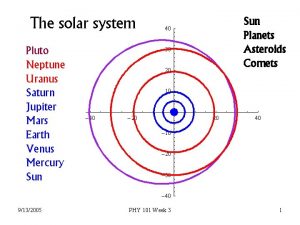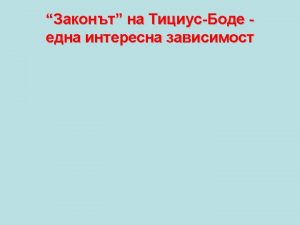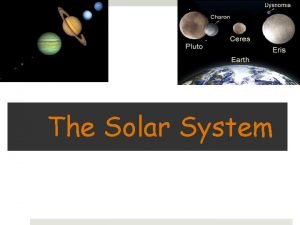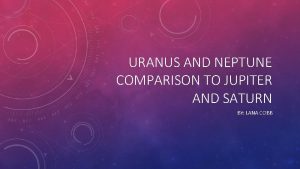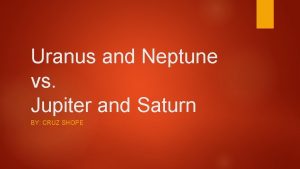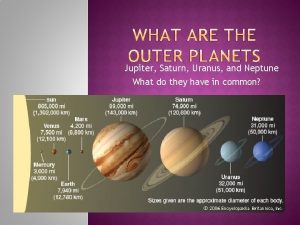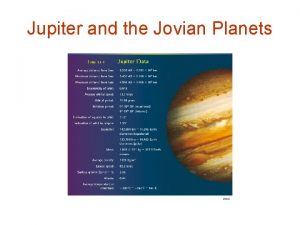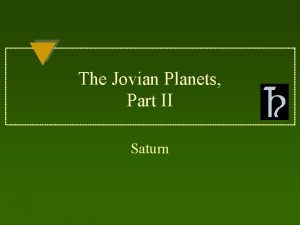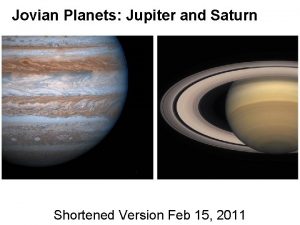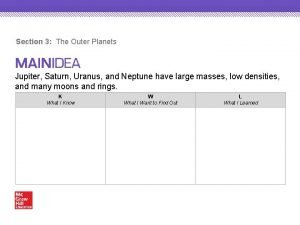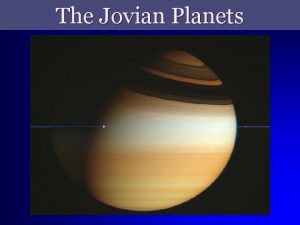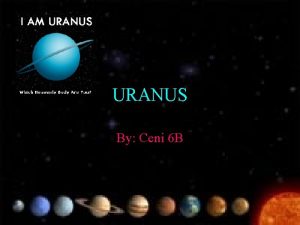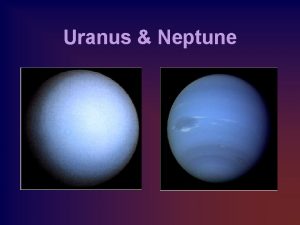Planets Overview Jovian Planets Jupiter Saturn Uranus Neptune





























- Slides: 29

Planets Overview

Jovian Planets Jupiter, Saturn, Uranus, Neptune • Far from sun • Cold temperatures • Large atmospheres – mostly • • Hydrogen and Helium Low density Orbits far apart Many moons Rings

Terrestrial Planets • • • Small Close to Sun Little or no atmosphere Few or no moons Rocky surface Spaced close together

Mercury never strays far from the sun seen right before sun sets or right before sunrise looks like it is following the path of the sun or the sun is following in its path

Mercury Rotation - tidally locked with Sun- similar to how the moon is tidally locked to the earth. 1 day = 2 mercury years = 6 earth months temperature range 100 K to 700 K largest temperature range of any planet Caused because there is no atmosphere, the slow rotation (one solar day is 6 earth months), and its proximity to the sun.

Mercury smallest planet density is greater than Venus or Mars but less than earth. no atmosphere low surface gravity heavily cratered evidence to suggest volcanic activity in the past Scarp - long cliff across Mercury’s surface probably formed from shrinking due to cooling of the crust

Mercury Caloris Basin - very large impact crater Probably sent seismic waves through planet Created the weird terrain on the other side

Venus - 3 rd brightest object in sky (Our sun 1 st and the moon 2 nd ) - 70 % of light reflected off its surface ( 10% Moon and Mercury - Close to the sun - Seen as a Morning or evening star – same as Mercury - Often called earth’s sister planet most closely related to earth in terms of physical characteristics ( size, density, composition ect) - radius 6000 km -. 82 times the mass of earth

Venus rotation - discovered by doppler radar because we cannot “see” the surface of Venus because of the immense cloud cover. -243 day retrograde rotation ( rotates in the opposite direction as the other planets. ) - Probably rotated the same direction as the other planets at first but during the early stages of planet formation collided with a planet sized object that hit Venus on the equator and in a way that stopped it rotating in that direction and started it rotating slowly in the opposite direction.

Venus Atmosphere 96. 5% CO 2 3. 5 % N 2 trace amounts of water vapor, carbon monoxide, sulfur dioxide and argon. Color in atmosphere comes from the sulfur in the upper atmosphere.

Venus Surface temperature of 730 K both night and day. The high temperature probably caused by the runaway green house effect Some scientists worry that if we put too many greenhouse gasses in our atmosphere we may experience a runaway greenhouse effect similar to Venus.

Our Moon diameter 347 km ( 1/4 the earth ) gravity 1/6 the earth Moonquakes - up to 3000 per year - moon has an outer crust similar to the earth age - about 4. 6 billion years Only see one side of the moon – tidally locked with the earth No atmosphere - wide variations in temperature

Our Moon Highlands large amounts of deep regolith (soil) Silicon, aluminum rocks light colored original surface of the moon ( approx 4. 5 billion years old) Maria ( seas ) 16 % of moon’s surface Dark colored mostly on near side iron and magnesium rock formed from volcanoes less regolith Younger than highlands

Our Moon PHASES OF THE MOON AND SUN AT NORTH POLE

Formation of Our Moon 3 hypothesis on formation 1) captured by earth’s gravity ( Capture theory ) 2) Earth and moon formed at the same time ( Sister theory ) 3) Formed from part of earth ( Daughter theory ) • Most accepted theory • Impacted by a Mars sized object • Explains low concentrations of iron on the moon • Explains rotation axis tipped more than other planets

Mars Density 3900 kg/m 3 Radius 3400 km -. 53 earth’s radius. 11 times the mass of the earth axis is inclined 24 degrees to the perpendicular compared with 23. 5 for the earth. 15 % of sunlight reflected compared to 70 % for Venus

Mars Orbit - eccentric 3 rd greatest in the solar system 1. 38 AU at the closest point vs. 1. 67 AU at the farthest point 45 % more light at the closest point ( 249 million km closer to sun) Closest point to the sun corresponds with the southern hemispheres summer and the northern hemispheres winter. Southern hemisphere has more extreme seasons (hotter summers and colder winters) than the northern hemisphere. One of the reasons for the intense winds storms that occurs during the southern hemispheres summer.

Mars Moons Phobos ( fear ) orbits close – will eventually collide with the planet. Deimos ( panic)orbits farther out – will eventually escape the planets gravity.

Mars Surface of Mars northern hemisphere volcanic activity (all the volcanoes are on the northern hemisphere), volcanic plains, younger terrain Southern hemisphereheavily cratered surface – probably the original crust of the planet (4. 5 billion years old)

Mars Evidence for water - runoff channels - similar to stream channels on earth - outflow channels- formed during periods of extensive flooding – usually found near the equator region. - fluidized ejecta – meteorite impacts where the area around the impact appears like ripples causes by water. Probably caused by frozen water close to the surface. When the meteor hit it melted the ice for a short time and then the water refroze in the ripples.

Jupiter Jupiter is the largest planet in the solar system. It is the 4 th brightest object in the sky. Measured across, Jupiter is ten times the size of the Earth and one -tenth the size of the Sun. It is mostly hydrogen and helium. There is a small (2 -3 times the size of earth) core of rock at the center. This is surrounded by an ocean of liquid hydrogen and helium in the form of a metal. The liquid and metallic hydrogen give Jupiter it’s large magnetic field.

Galilean Moons Io – small, constant volcanoes because of the gravitational pull on the moon from Jupiter. Europa – Cracks in the ice at the surface give evidence of huge amounts of liquid water underneath. Ganymede- larger than Mercury Callisto

Saturn Last planet known to the ancient society Primarily hydrogen and helium Very low density at cloud top temperature is 97 K 18 moons Sun is only the brightest of a candle

Titan The one large moon of Saturn Reddish color Atmosphere is 90 % nitrogen and up to 10 % argon Large amounts of methane and ammonia Earth of the Cold

Uranus First planet to be discovered Tilted 98 degrees from the perpendicular Retrograde spin orbital period about 84 years Tilt could have been caused by a collision

Moons of Uranus 17 moons – five major moons , Titania, Oberon, Ariel, Umbriel, Miranda

Neptune’s Moons 8 moons – Triton the largest Triton – retrograde orbit • large fissures, frozen lakes of ice (volcanic), liquid nitrogen geysers • probably a captured Kepler belt object • will be torn apart by Neptune’s gravity- no more than 100 million years.

Pictures

 What are jovian planets made of
What are jovian planets made of Neptune jovian
Neptune jovian Uranus outline
Uranus outline Uranus neptune size comparison
Uranus neptune size comparison Phase diagram methane
Phase diagram methane What does jupiter have in common with neptune brainpop
What does jupiter have in common with neptune brainpop Mars, jupiter, and saturn show retrograde motion because
Mars, jupiter, and saturn show retrograde motion because Neptun saturn
Neptun saturn The two outer jovians appear bluish in color because
The two outer jovians appear bluish in color because Mars, jupiter, and saturn show retrograde motion because
Mars, jupiter, and saturn show retrograde motion because Why do jovian planets have rings
Why do jovian planets have rings Jupiter magnetosphere
Jupiter magnetosphere The two outer jovian planets appear bluish in color because
The two outer jovian planets appear bluish in color because Jupiter's layers
Jupiter's layers Inner terrestrial planets
Inner terrestrial planets What do the first four outer planets have in common
What do the first four outer planets have in common Solar system jeopardy
Solar system jeopardy What separates the inner planets and outer planets
What separates the inner planets and outer planets Jovian
Jovian Whats the third planet from the sun
Whats the third planet from the sun Huygens
Huygens Distance from the sun saturn
Distance from the sun saturn Feature of mercury
Feature of mercury Uranus angered gaea by
Uranus angered gaea by Jupiter length of days
Jupiter length of days Hepheasteus
Hepheasteus One day on uranus
One day on uranus Difference between solar and lunar eclipse
Difference between solar and lunar eclipse Steckbrief aufbau
Steckbrief aufbau Neptune up close
Neptune up close

